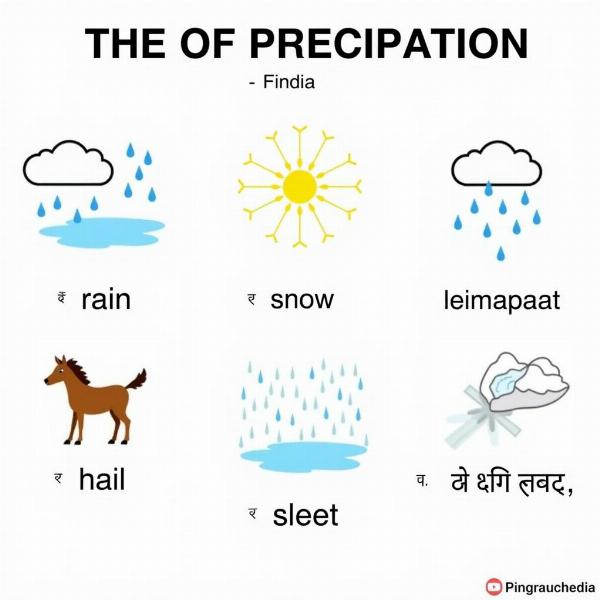Understanding the meaning of precipitation is crucial for anyone interested in meteorology, geography, or even just the daily weather. Precipitation, in its simplest terms, refers to any form of water falling from the atmosphere to the Earth’s surface. This includes rain, snow, sleet, and hail. But what does this mean in Hindi? This article will delve into the meaning of precipitation in Hindi, exploring its various forms, significance, and cultural relevance.
What is the Hindi Word for Precipitation?
The most common Hindi word for precipitation is वर्षण (varṣaṇ). This term encompasses all forms of water falling from the sky. While other words might describe specific types of precipitation, varṣaṇ acts as an umbrella term, much like “precipitation” in English. Knowing this word is fundamental to understanding weather reports and discussions about climate in Hindi.
Different Types of Precipitation and Their Hindi Equivalents
While varṣaṇ is the general term, Hindi also has specific words for different forms of precipitation:
- Rain: बारिश (bāriś) is the most common and widely understood word for rain.
- Snow: हिमपात (himapaat) refers to snowfall. You might also hear बर्फ (barf), which means snow itself, rather than the act of snowing.
- Hail: ओला (olā) is the word for hail. ओलावृष्टि (olāvṛṣṭi) is another term that specifically denotes a hailstorm.
- Sleet: बर्फ़ीली बारिश (barfīlī bāriś) literally translates to “icy rain” and is often used to describe sleet.
 Different Types of Precipitation in Hindi
Different Types of Precipitation in Hindi
The Importance of Precipitation in India
Precipitation plays a vital role in India’s agriculture-dependent economy. The monsoon season, characterized by heavy rainfall, is crucial for replenishing water resources and ensuring a good harvest. Too much or too little rain can have devastating consequences, leading to floods or droughts. Understanding continental climate meaning in hindi helps grasp the importance of precipitation patterns in shaping the climate of various regions.
Cultural Significance of Precipitation
In India, rain is not just a meteorological phenomenon; it holds cultural and religious significance. Many festivals and rituals are associated with rain, reflecting its importance in sustaining life and prosperity. For example, the festival of Teej celebrates the arrival of the monsoon and is marked by prayers for abundant rainfall.
How is Precipitation Measured in India?
Precipitation is measured in millimeters (mm) using rain gauges across the country. The Indian Meteorological Department (IMD) is responsible for monitoring and forecasting rainfall patterns.
What does low precipitation mean?
Low precipitation refers to periods of less rainfall than average, potentially leading to drought conditions.
What causes precipitation?
Precipitation occurs when water vapor in the atmosphere condenses and falls to the earth. This can happen due to various atmospheric conditions, including changes in temperature and pressure. Understanding concepts like continentality meaning in hindi can help understand how landmasses influence precipitation patterns.
Conclusion
Understanding the meaning of precipitation in Hindi, varṣaṇ, along with its various forms, is essential for grasping discussions about weather, climate, and agriculture in India. It’s a term deeply intertwined with both the scientific and cultural fabric of the country. From the anticipation of the monsoon rains to the scientific measurements of precipitation, varṣaṇ and its related terms hold significant meaning for the people of India.
FAQs
- What is the most common type of precipitation in India? Rain (बारिश – bāriś) is the most common type of precipitation in India.
- Which season in India experiences the highest precipitation? The monsoon season (June to September) experiences the highest precipitation in India.
- What is the Hindi word for hailstorm? ओलावृष्टि (olāvṛṣṭi) is the Hindi word for hailstorm.
- Why is precipitation important for India? Precipitation is crucial for India’s agriculture, which forms a significant part of its economy.
- What is the unit of measurement for precipitation in India? Millimeters (mm) is the unit of measurement for precipitation in India.
- What does the word ‘himapaat’ mean in Hindi? ‘Himapaat’ (हिमपात) means snowfall in Hindi.
- Besides ‘barf’, what is another word used for snow in Hindi? While ‘barf’ (बर्फ) means snow itself, ‘himapaat’ (हिमपात) describes the act of snowing.
Meaning-Hindi.in is your premier resource for professional Hindi translation services. We specialize in a wide array of translation needs, from business and legal documents to technical manuals and website localization. We also provide expert translation for educational and academic materials, offering fast and accurate services in various specialized fields. Need a reliable Hindi translation for terms like cirrus clouds meaning in hindi or solubility meaning in hindi? Our team of experienced translators ensures accuracy, cultural sensitivity, and timely delivery. alpine vegetation meaning in hindi might also be of interest. Contact us today at [email protected] or call us at +91 11-4502-7584. Meaning-Hindi.in – your trusted partner for all your Hindi translation needs.